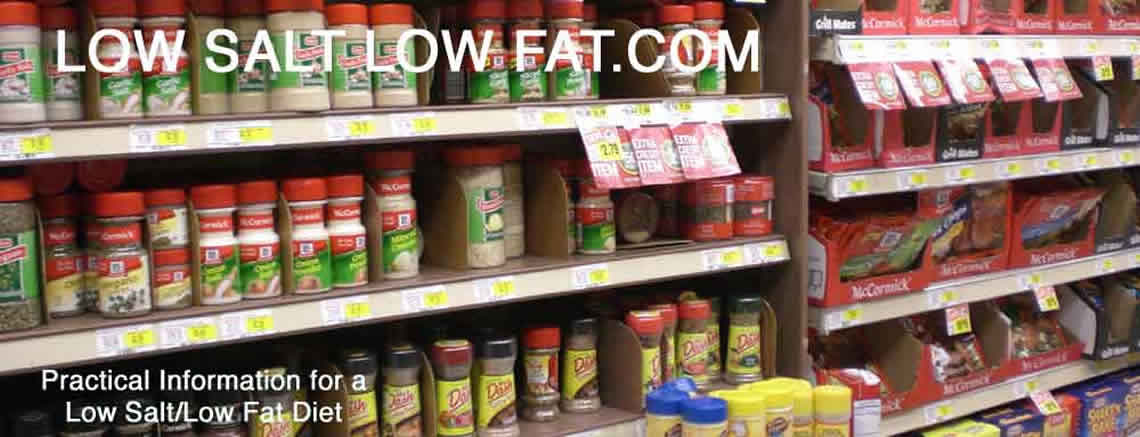A LS/LF diet makes eating at most restaurants a challenge as most menu items are loaded with salt and fat. Our nutrition data website page has many sources of information on menu items at many chain restaurants and their salt and fat content.
Being on a low sodium diet does not mean you have to give up the enjoyment of eating out. It does however mean you need to prepare and be selective in your choice of restaurants and menu items. Things to remember when dining out:
IF YOU ARE PLANNING ON EATING OUT, MAKE YOUR OTHER MEALS THAT DAY VERY LOW IN SODIUM. Any meal you eat out will most likely have more sodium than you would normally have at home. To compensate for that reality, be sure that the other meals you have that day are very low in sodium. Planning ahead can allow you to remain within your daily sodium restriction.
IF POSSIBLE, CALL THE RESTURANT AHEAD OF TIME TO BE SURE THEY ARE WILLING TO PREPARE YOUR MEAL WITHOUT ANY MONOSODIUM GLUTAMATE (MSG), SALT OR SAUCES. If they are reluctant or indicate it depends on how busy the chef is, select another restaurant. If the restaurant is willing to prepare a special meal for you, ask if you need to bring any special condiments, i.e.: seasonings, unsalted butter, low sodium sauce, low sodium salad dressings, etc. If you are unable to call ahead, ask about the feasibility of making a special meal before you are seated. It is better to know before you are seated, so you can decide if you will remain or go to another restaurant.
WHEN AT THE RESTAURANT EXPLAIN TO THE WAITER/WAITRESS THAT YOU ARE ON A LOW SALT DIET and ask that they or the chef recommend which of their menu items are the lowest in salt content and without MSG. Do not always assume “heart healthy” on a menu translates to low salt. It typically means the item is low in fats and cholesterol, if you are lucky these items will also be low in sodium.
CHECK OUT THE SERVING SIZE: Many restaurants often provide larger portions than necessary. If you are at a restaurant known for its large meals, request that half of the serving be placed in a take home box for a left over meal the next day. Although you may be tempted to eat more, stay within your normal portion size, remember the larger the portion, the higher the sodium.
CHOOSE FOODS THAT REQUIRE MINIMAL PREPERATION such as baked, and roasted. Avoid foods that are made with breading, batters, marinades or laden with sauce.
WHEN ORDERING, DON’T ASSUME THEY REMEMBER, AGAIN ASK THAT YOUR MEAL BE MADE WITHOUT ANY MSG, ADDED SALT OR SALTED BUTTER. Many restaurants today have unsalted butter available in their kitchen, ask that this be used.
CHOOSE FRESH FRUITS AND VEGETABLES when available.
CARRY YOUR OWN SALT FREE CONDIMENTS. When you know you will be eating out, go to a “Dollar Type Store” and purchase several small cosmetic/toiletry travel storage containers and depending on the type of restaurant, fill containers with single servings of your favorite low sodium salad dressing, low sodium ketchup/mustard/mayo, sauce, seasoning and unsalted butter, etc
WATCH THE SALAD BAR as many salad bars are enriched with sodium nitrate to help preserve their freshness. Ask if a preservative is used on the salad bar. Where possible, request that you have your salad prepared fresh and use vinegar and oil or lemon and oil as your dressing or use the low sodium version you brought with you.
DESSERTS ARE NOT OFF LIMITS you just need to be selective. You are celebrating by eating out so enjoy some dessert. However, skip the pies, pastries, cakes and tortes, instead select sherbet, ice cream and fresh fruits.
VISIT www.lowsaltfoods.com for additional advice on eating out and specific sodium information on fast foods.
ENJOY THE MEAL YOU AND/OR YOUR LOVED ONE DID NOT HAVE TO COOK!! If you find a restaurant that has graciously prepared good tasting, low sodium meals for you, please email me at info@SaltWatcher.com. Provide the restaurant name, address and phone number, if possible. I will contact the restaurant and if they are agreeable will post here as a dining out resource.
It is likely that your medical team has told you to avoid them totally. Since January 2006 FDA has required food manufacturers to disclose transfats on package foods and as a result it has virtually disappeared from your supermarket shelves.
However, transfats are alive and well in restaurant menus where FDA does not require disclosure. Fortunately some local jurisdictions require disclosure of transfats on menus and a few are even banning them. On the nutritional data page there are links for checking transfat content of most national restaurant chains. McDonald's menu is still full of them.
Beware that the doughnut industry is having trouble finding a replacement for transfats, which is odd since they have only been commercially available since 1911. Thus many commercial doughnuts still contain transfats. Krispy Kreme announced 1/7/08 that its entire menu is now free of transfats, so it is possible. However, even without transfats doughnuts are not exactly a health food.
Many biscuit mixes sold to restaurants contain transfats even though biscuit mixes on your supermarket shelf do not. If you are a biscuit fan, you might want to ask your favorite restaurant how they are made before you order them.
In general, consider asking restaurants about their postion on transfats in menu items. At the very least it will speed their elimination os use of this dangerous ingredient.

